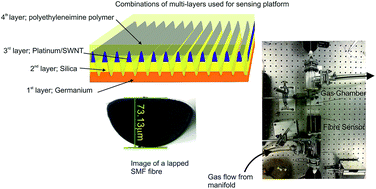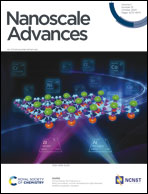Detection of nitrous oxide using infrared optical plasmonics coupled with carbon nanotubes†
Abstract
Interest in gas sensing using functionalised carbon nanotubes is a major area of research that utilises changes in their electrical properties induced by the reaction with a specific gas. This paper describes specific gas sensing on an optical platform consisting of a 2-dimensional nano-structured plasmonic array of nano-antennae/nanowires, with topological dimensions of mean radius of 130 nm, typical length of 20 μm and a period of 500 nm. The array is created by the spatial compaction of germanium oxides when the material interacts with ultra-violet irradiance, it can support infra-red localised surface plasmons. Carbon nanotubes are deposited upon the surface of the plasmonic platform followed by the application of the polyethyleneimine polymer. The resulting nanomaterials-photonic platform gives rise to the selective response to nitrous oxide gases, which are a major contributor to atmospheric degradation. We achieve the device sensitivity up to 100% atmosphere of nitrous oxide with a detection limit of 109 ppm, a maxiumum response time of nineteen seconds and yielding a full-scale deflection of +5.7 nm. This work demonstrates that the optical properties of specific carbon nanotubes can be used in a wide range of sensing applications offering a new sensing paradigm.

- This article is part of the themed collection: Welcome to the community


 Please wait while we load your content...
Please wait while we load your content...